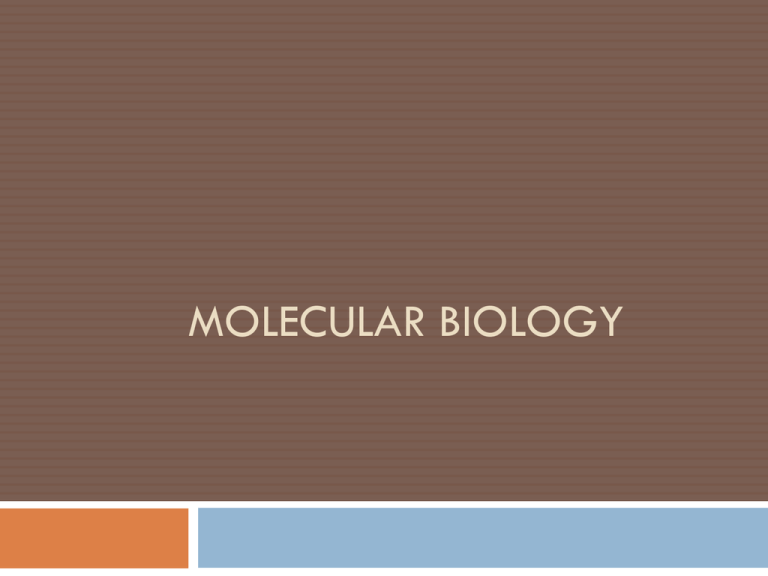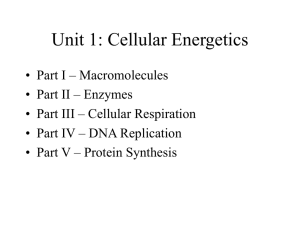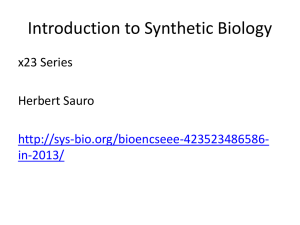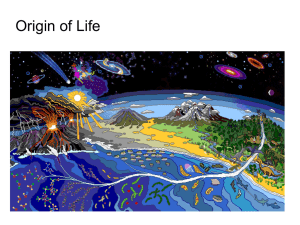Biochemistry Notes
advertisement

MOLECULAR BIOLOGY Elements present in your body other than water… Carbon-30% of all biomass, original source of C is CO2 from photosynthesis Hydrogen Nitrogen Oxygen Phosphorus Sulfur If carbon is present then the compound is considered organic. Carbon is the most versatile element b/c of its ability to bond to itself and other elements. It is tetravalent (4 bonds). If C and H are present it is a hydrocarbon: most are energy sources (fossil fuels) Molecules in living organisms: proteins, carbohydrates, lipids, nucleic acids Most are polymers of smaller, covalently bonded, molecules called monomers. Functional groups: groups of atoms with specific chemical properties and consistent behavior. The consistent behavior of functional groups allows one to recognize the properties of molecules that contain them. i.e. polarity, electronegativity Figure 3.1 Some Functional Groups Important to Living Systems (Part 2) Aminescontain N, act as a base Phosphat esinvolved in E transfers Sulfur in sulfhydrls make disulfide bridges in protein Figure 3.1 Some Functional Groups Important to Living Systems (Part 1) Hydroxyls - act as an alcohol or polar Aldehydes , Ketones, have one double bond to O Carboxyls have two Os, one double, one single bond FUNCTIONAL GROUPS SERVE IMPORTANT PURPOSES IN MOLECULES Estradiol Female lion Testosterone Male lion Isomers Structural Isomers Structural isomersame chemical formula, different arrangement of atoms. Figure 3.2 Optical Isomers Optical Isomers Same chemical formula, arranged Bio around an differently asymmetrical carbon Biochemical Unity Biochemical unity-organisms can acquire needed biochemicals by consuming other organisms. Because all macromolecules have the same chemistry: The four biological molecules are present in the same proportions in all living things. Argument for common ancestor Figure 3.3 Substances Found in Living Tissues 70% water The function of macromolecules is directly related to their 3-D shape and their chemical properties/formula. This will determine molecular interactions such as solubility. Synthesis Question Question: Carbon is an extremely important element to all life forms on the planet. Life on Earth, as we know it, could not exist without this element. In no more than three sentences, A) Identify the ultimate source of all Carbon for living organisms alive today and B)provide two brief explanations of why Carbon is important molecularly speaking. Scoring Rubric: 1pt. The ultimate source is CO2 from the atmosphere. 1pt. Discussion of source of carbon for making Carbohydrates, Lipids, Proteins, and Nucleic Acids. 1pt. Discussion of the tetravalence allowing for a wide range of different molecules. 1pt. Correct use of scientific terms. 1pt. Answer has no more than three sentences. (Following Directions.) Molecular Biology Polymers are formed in condensation reactions AKA dehydration synthesis. Condensation reactions result in monomers joined by covalent bonds. These require E http://nhscience.lonestar.edu/biol/dehydrat/dehydrat.html The reverse of a dehydration synthesis is hydrolysis reaction which break apart polymers and turn them into monomers. These make E Figure 3.4 Condensation and Hydrolysis of Polymers (A) Figure 3.4 Condensation and Hydrolysis of Polymers (B) DEHYDRATION AND HYDROLYSIS REACTIONS Short polymer Unlinked monomer Dehydration removes a water molecule, forming a new bond Longer polymer Dehydration reaction in the synthesis of a polymer Hydrolysis adds a water molecule, breaking a bond Hydrolysis of a polymer Carbohydrates See the Carbonyls and Hydroxides? Carbohydrates (C,H,O 1:2:1) Molecules that contain carbons flanked by a H group and an OH group. Four major types of carbs: mono, di, poly, and oligo saccharides. Two major functions: Source of energy that can be released in a usable form to body tissues Serve as carbon skeletons for other 3 macromolecules. Monosaccharides Produced through photosynthesis. All living cells contain glucose. Most monosaccharides are in the D series of optical isomers (proteins are L) Figure 3.13 Glucose: From One Form to the Other (Part 2) Figure 3.14 Monosaccharides Are Simple Sugars (Part 1) Figure 3.14 Monosaccharides Are Simple Sugars (Part 2) Structural These are structural isomers. Glycosidic Linkages Monosaccharides covalently bind together in condensation reactions to form glycosidic linkages. Glycosidic linkages can be α or β. Examples of disaccharides sucrose — table sugar = glucose + fructose lactose — milk sugar = glucose + galactose maltose — malt sugar = glucose + glucose Figure 3.15 Disaccharides Are Formed by Glycosidic Linkages (Part 1) Figure 3.15 Disaccharides Are Formed by Glycosidic Linkages (Part 2) ThiThis is cellobiose, a subunit of cellulose, humans don’t have the enzymes to break this down, but cows do. To us it is merely roughage. Cellulose is a very stable glucose polymer, and is the principle component of cell walls. Oligosaccharides (3-20) Often covalently bonded to proteins and lipids on cell surfaces and act as recognition signals. ABO blood groups Polysaccharides Formed by glycosidic linkages, animal and plant energy storage form. Three forms: starch, glycogen, cellulose, and chitin. Starch and glycogen easily hydrolyzed for energy. Starch- all contain alpha linkages, stored in plants. Cellulose- plant cell wall structure; most abundant organic molecule on earth Glycogen-energy storage in animals Chitin- found in exoskeletons and fungi cell walls Polysaccharides Glucose must be stored as glycogen because glycogen does not exert as much osmotic pressure on the cell as one glucose molecule Figure 3.16 Representative Polysaccharides (A) Carbohydrate Energy Storage Figure 3.16 Representative Polysaccharides (B) Cellulose, Starch, & Glycogen Chemically Modified CHOs Some CHO can be modified by adding functional groups such as a phosphate or amino group. Phosphate sugars and amino sugars Lipids –C,H,O Lipids are hydrocarbons that are insoluble in water because of their nonpolar, covalent bonds. All the extra H= 2x E of CHO Hydrophobic. One lipid molecule consists of a glycerol (alcohol) bonded to 3 fatty acid chains. The fatty acids are held together through van der Waals forces not covalent bonds; therefore they are not true polymers. Lipids The bond that holds each fatty acid molecule to the glycerol is formed through dehydration synthesis, and is called an ester linkage. The ester linkage is a covalent bond. ESTER LINKAGE AND LIPIDS Fatty acid (palmitic acid) Glycerol Dehydration reaction in the synthesis of a fat Math Quiz Tell if each pH or pOH is an acid, base, or neutral by writing ACID, BASE, or NEUTRAL on the line next to the prompt. (1 points each) pH 3 ____________ pH 14 _______________ pOH 7 ______________ pH 7 ____________ pH 4 ______________ pOH 14 ____________ pOH 2 ____________ pOH 0 ______________ pOH 9 _____________ pH 10 _____________ Calculate pH differences in H concentration pH 2- pH 5 pH 1- pH 3 pH 1- pH 2 pH 10- pH 14 pH 3- pH 8 pH 3- pH 7 pH 7 – pH 10 pH 5 – pH 10 pH 1- pH 14 pH 1- pH 11 Figure 3.18 Synthesis of a Triglyceride Lipid Functions Fats and oils store energy Phospholipids in cell membrane for structure Carotenoids Hormones and vitamins Fat = insulation (Camels) Lipids coat neurons for electrical insulation Oil and wax on skin surface repel water Lipids One lipid unit is called a triglyceride/triglycerol. Triglycerides solid at room temp. are fats. Saturated fatty acid- all C-H bonds are single Animal fat, least healthy. Triglycerides liquid at room temp. are oils. Unsaturated fatty acid (mono, poly) some of the C-H bonds are double causing kinking in the hydrocarbon chain. Plant oils, lower melt. pt., healthier Polyunsaturated Fats- many double bonds, usually in plants Hydrogenated or Trans Fat- Unsaturated turned saturated Saturated vs. Unsaturated Figure 3.19 Saturated and Unsaturated Fatty Acids Phospholipids A phosphate molecule bonds to the glycerol replacing one hydrocarbon chain (fatty acid). Since phosphate functional group is (-) it is hydrophilic and attracts polar H20 molecules. In aqueous environment, phospholipids line up with hydrophobic region “tails” on one end, and hydrophilic “heads” on the other. Phospholipids form a bilayer. Figure 3.20 Phospholipids (A) Figure 3.20 Phospholipids (B) Phospholipid bilayers form biological membranes. Waxes Steroid Structure LE 4-9 Estradiol Female lion Testosterone Male lion Cell Membranes Lipid storage Energy and Macromolecules Data Set 6 Proteins- suffix “lin” eg insulin Contain: C, H, O, N, P, and S Protein monomers are known as amino acids, which then fold into the polypeptide form of proteins. 50% of organisms biomass Essential Amino Acids Over 20 amino acids 11 non-essential 9 essential These 9 are essential because they cannot be synthesized by the body and must be supplemented. Phenyalanine Valine Threonine Tryptophan Isoleucine Methionine Leucine Lysine Histidine Protein Structure Can be made of more than one polypeptide chain The sequence of amino acids in each polypeptide chain is the source of diversity in protein structure and function. What Are the Chemical Structures and Functions of Proteins? Amino acids have carboxyl and amino groups—they function as both acid and base. Rgroup= property Table 3.2 (Part 1) These hydrophylic amino acids attract ions of opposite charges. Table 3.2 (Part 2) Hydrophylic amino acids with polar but uncharged side chains form hydrogen bonds Table 3.2 (Part 3) Hydrophobic amino acids Table 3.2 (Part 4) Proteins Amino acids bond together covalently by peptide bonds to form the polypeptide chain. The beginning of all polypeptides begin with the amino group of an amino acid: the N terminus and the end of the chain is the carboxyl group: the C terminus NC orientation Figure 3.6 Formation of Peptide Bonds The peptide bond is inflexible—no rotation is possible. Protein Structure Primary Structure-sequence of amino acids in the polypeptide chain. Peptide backbone –N-C-C. Secondary Structure- determined by hydrogen bonds, alpha helix and beta pleated. Bonds between amino (H) and carboxyl (C and O) Tertiary Structure- additional folding between the R groups (side chains). Folded by disulfide bridges, cysteine has the sulfur. Quarternary Structure- result from subunits (separate tertiary structures) folding together. Multiple polypeptides together. Figure 3.7 The Four Levels of Protein Structure (A) Figure 3.7 The Four Levels of Protein Structure (B, C) Figure 3.7 The Four Levels of Protein Structure (D, E) Primary (1’) sequence Primary Structure is IMPORTANT SICKLE CELL AND OXYGEN TRANSPORT Sickle-cell hemoglobin Normal hemoglobin Primary structure Val His 1 2 Leu Thr 3 4 Pro Glu 5 6 Secondary and tertiary structures Function 7 subunit Normal hemoglobin (top view) Molecules do not associate with one another; each carries oxygen. Primary structure Secondary and tertiary structures His 1 2 Leu Thr 3 4 Function Val Glu 5 6 7 subunit Sickle-cell hemoglobin a Pro Exposed hydrophobic region a Quaternary structure Val a Quaternary structure Glu Molecules interact with one another to crystallize into a fiber; capacity to carry oxygen is greatly reduced. a 2’ structure 3’ Structure 4’ Structure Protein’s Natural Form Protein Function Structural support Protection Transport Catalysis- speeding up a chemical reaction Defense Regulation Movement Protein denaturation Denaturation= loss of 3-D shape and function (unfold due to environmental stressors) Proteins are sensitive to their environment due to weaker bonds in the 2nd and 3rd structure. 3 Denaturing factors: Increased temperature Alterations in pH Salt concentration changes Denaturation is usually irreversible Figure 3.11 Denaturation Is the Loss of Tertiary Protein Structure and Function Protein Shape Sometimes proteins will bind to the wrong ligand (molecule) while completing their folding process. E.g. alzheimer’s Chaperonins- type of protein that prevents misfolding. Enzymes Enzymes are proteins that are catalysts that speed up chemical reactions in cells. Words that end in “ase” are enzymes Enzymes form an enzyme-substrate complex Animation: How Enzymes Work Nucleic Acids- C,H,O,P,N Nucleic acids are polymers designed for storage, transmission, and use of genetic information. DNA & RNA DNA encodes our heredity info. DNA contains the info, uses RNA to create an amino acid sequence (proteins) which carry out life’s functions. Pyrimidines: cytosine, thymine, uracil Purines: adenosine, guanine Nucleotide Nucleotides are the monomers for nucleic acids. Each nucleotide consists of a pentose sugar, phosphate group, and nitrogenous base. Nitrogenous bases can be pyrimidines (single ring) or purines (2 fused rings) Pyrimidines-C,T,U Purines-G, A 3.5 What Are the Chemical Structures and Functions of Nucleic Acids? DNA—deoxyribose RNA—ribose DNA & RNA Backbone Alternate pentose sugar and phosphate groups (SP-S-P-S-P…) The nitrogen bases project off the backbone. Nucleotides bonded by phosphodiester linkages. Phosphodiester linkages form between the sugars linked by the phosphate. Figure 3.24 Distinguishing Characteristics of DNA and RNA (Part 1) DNA Hydrogen bonds link nitrogenous bases together. Base pairing rule-purine and pyrimidine always pair up. A-T and C-G in DNA A-U and C-G in RNA Know why base pairing is complimentary p.59 Figure 3.24 Distinguishing Characteristics of DNA and RNA (Part 1) DNA Relationships DNA in all organisms, chimps and humans share 98% base sequence with humans. Scientists use DNA to determine evolutionary relationships. Nucleotides also are used in energy reactions. (ATP and GTP). Nucleotides are used in hormones and the nervous system (cAMP). HW: Due Friday 8-30-13 Macromolecule Type Name of Molecule Source Role in Organisms (What does it do?) 5 Carbohydrates glucose plants Immediate energy 5 Lipids 5 Proteins 4 Nucleotides How did life begin? Could life have come from outside earth? Allan Hills region of Antartica, meteorite from Mars Miller and Urey experiment 1953- chemical evolution. Took inorganic substances and made them organic Miller and Urey Experiment RNA world before DNA- RNA less stable than DNA RNA ribozymes could replicate itself Ribozymes are responsible for peptide bonds Figure 3.27 Was Life Once Here? Energy Source- Stanley Miller Figure 3.28 Synthesis of Prebiotic Molecules in an Experimental Atmosphere (Part 1) 4 Steps for Life to Emerge on Earth 1. Abiotic synthesis of amino acids and nucleic acids. 2. Monomers must join to make polymers 3. RNA/DNA form and gain ability to reproduce and stabilize using bonds and complimentary bonding. 4. Evolution of the “protobiont” first life form Evidence for #1: Abiotic synthesis Miller and Urey- hypothesized about early earth’s organic composition… H2, CH4, NH3 and H2O vapor… These things formed amino acids and oils… The compounds came from volcanic eruptions and the energy from lightning… These compounds collected in the oceans and wala life… Evidence for #2: Polymerization Researchers have taken fool’s gold, sand, and clay, and exposed to it to intense heat… In the presence of water (tides) amino acids and oils become polymers Evidence for #3: RNA/DNA Some RNA can act as ribozymes that act as great info storage bins… Over time it is believed RNA evolved into a more stable DNA… Evidence for #4: Protobiont Formation Experiments show that lipids and other molecules can form membranes (cell)… Over millions of years they become prokaryotic cells Representation of a Protobionts Question: In no more than three sentences, explain why the abiotic synthesis of the nucleic acids RNA and DNA was overall so essential to helping Data Set Question (U1,D3) Synthesis Question (U1, D3) Question: In no more than three sentences, explain why the abiotic synthesis of the nucleic acids RNA and DNA was overall so essential to helping generate life on Earth? (5 Points) 1pt. Discussion of the ability to store molecular information on the construction of molecule 1pt. Discussion of inheritance of information from one generation to the next 1pt. Discussion of the long term stability of DNA 1pt. Correct use of scientific terms. 1pt. Answer has no more than three sentences. (Following Directions.)









